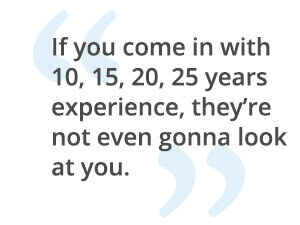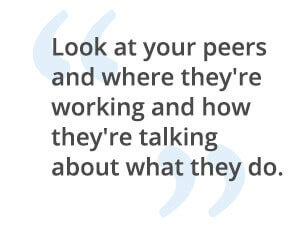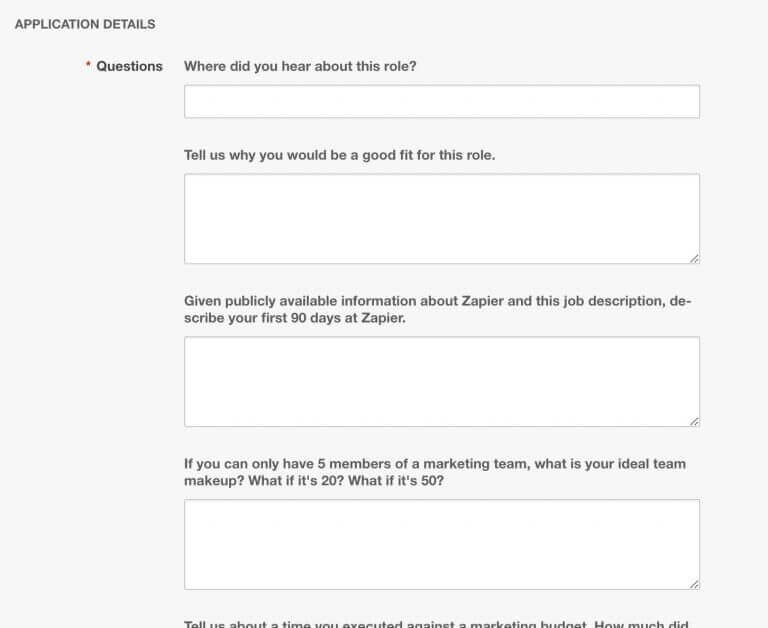“The client specifically asked for ‘young pretty people,’” Tejal Wagadia, a technical recruiter based in Phoenix, Arizona, told Jobscan. “They said, ‘I don’t care how many years of experience they have, I need young pretty people.’“
“I’ve talked to VPs of HR who have told me, straight out, that the executive needs candidates that are younger,” veteran Silicon Valley recruiter Linda Tuerk told Jobscan. “I actually saw a person, a VP of HR, print out photos from LinkedIn of young white men and hold them up in a conference room and said, ‘We want this.’”
What is Age Discrimination in Hiring?
These are blatant examples of age discrimination, or ageism, in hiring. Not only is it unfair and immoral, it is illegal.
“The Age Discrimination in Employment Act (ADEA) forbids age discrimination against people who are age 40 or older,” states the U.S. Equal Employment Opportunity Commission website. This includes applicants and employees alike.
From a practical standpoint, “age discrimination is when [a hiring company] uses a person’s age as a judgement for if they’re qualified for a job,” Melissa Dobbins, founder of human resources startup Career Place, told Jobscan.
Age discrimination is a job search reality. “It’s not a myth or an urban legend,” said Wagadia. Unfortunately, unless a hiring company blurts out “you’re too old” directly to an applicant, it can be incredibly difficult to prove.
A Changing Workforce
The largest generation in the history of the world, Baby Boomers began getting their first jobs by the mid-1960s. With Boomers poised to dominate the workforce by the ‘70s and ‘80s, the ADEA was enacted in 1967 to protect vulnerable members of previous generations. Today, Millennials have overtaken Boomers and Gen X in both living population and in the workforce. Meanwhile, Gen Z is already graduating from college with innate tech savviness and the most up-to-date skill sets.
When it comes to single contributor roles, Boomers and Gen Xers (who are now in their 40s) are being pushed out by their Millennial and Gen Z counterparts. This leaves them competing for a limited number of management and leadership roles, but Dobbins is frustrated with the “fallacy” that management is the only path for workers after age 40.
“There are certain skills and interests that are required in management, and others that are required in single contributor roles [that] have nothing to do with age,” said Dobbins.”People who are fantastic at what they do, it makes no sense to force them into management or out of the discipline. Can you imagine an amazing writer suddenly becoming an editor because they crossed a certain age threshold? It makes no sense, and yet that’s exactly what’s happening in a lot of corporate environments.”
With expected retirement age rising, this generational tension won’t dissipate anytime soon.
Why and How Companies Discriminate Against Older Workers
Not all discriminatory companies are as blatant as Wagadia and Tuerk’s former clients. A company could be blind to their own biases or prioritizing younger candidates because they are looking for traits often associated with youth.
A few of the common concerns that lead to conscious and subconscious age discrimination include:
Energy and Stamina – The company is fast-paced and frequently requires employees to work overtime. This type of energy, stamina, and drive might correlate with young employees eager to make their mark, but exceptions abound.
Tech Savviness – The company is using cutting-edge technology and the latest software. They don’t expect older employees to be up to date or quick to adopt new and innovative tools. “[Hiring managers] say they can’t afford the ramp up time for an older worker to come up to speed on a couple new skills,” said Tuerk.
Adaptability – The company might want employees to buy in to a system or be quick to adapt to an ever-changing environment. They don’t have the time to prod older employees who might have developed habits or be set in their ways.
Money – Understandably, older employees often lean on their experience to demand higher salaries. A younger, less-experienced candidate with a similar skillset can typically be paid less.
Companies are known to screen for some of these things right in the job listing. Examples of age discrimination in job listings include:
“Recent Graduates” – Despite high-profile companies coming under fire for using terms like “new grad” or “recent graduate” in their job postings, you’ll still find hundreds of listings using these terms if you search Google for Jobs. This illegal practice is explicitly mentioned on the EEOC website: “A help-wanted ad that seeks ‘females’ or ‘recent college graduates’ may discourage men and people over 40 from applying and may violate the law.”

Even if the preferred range isn’t mentioned on the job listing, applicant tracking systems like Taleo can be configured to automatically deemphasize or rule out applicants with “too much” experience.
Ad Targeting – Big corporations including T-Mobile and Amazon were recently named in a lawsuit for allegedly using Facebook’s ad targeting to serve job ads to people in select age ranges, “limiting some only to people younger than 38.”
“Digital Native” and other code words – “Companies use the term ‘digital native’ and that’s directly related to an age group of people that grew up in the digital age,” noted Tuerk. There are other veiled terms companies tend to use when seeking younger talent, such as “energetic” or “vibrant,” or when turning down an applicant, like “over-qualified” or citing “culture fit.”
How to Fight Age Discrimination
Until these practices stop, job seekers over 40 must learn how to counteract ageism in pursuit of a new job. Here are some ways job seekers can sidestep age discrimination.
Stay Current
Your years of experience can be of great value to the hiring company, but most experienced doesn’t always equate to most qualified. Your experience will not outweigh a younger applicant’s if they are on the cutting edge of industry trends, techniques, and technology but you are not.
Be proactive about staying on top of the latest software and progression in your industry, even if what you’ve been doing has been serving you just fine. Add new certifications to your resume to show that you’re continually advancing your skill set. Be an active participant in your industry’s goings-on via LinkedIn or in-person networking events.
Trim Down Your Resume and LinkedIn Profile
“Age discrimination is one of those [biases] that is the hardest to block when you’re dealing with resumes,” said Dobbins, noting the reliance on dates and experience. It can be painful to leave anything off for an applicant with a deep body of work, but recruiters see it as one of the primary strategies for combating age discrimination.
Don’t List Experience That is More Than 10-15 Years Old
“From a recruiter’s perspective or a hiring perspective, anything [10-12 years] old is irrelevant unless you’re trying to change your career,” said Wagadia.
Tuerk pled with older job seekers to “stop starting their LinkedIn profile or their resume with ‘20+ years experience.’ Drop that right away. Just talk about what’s relevant.”
“One of the best things an older candidate can do is to appear young is to know how to edit their experience,” said Tuerk. “It’s no longer seen a bad moral thing to not list all of your jobs lifetime. It’s OK to just go back 15 years and to concentrate on the skills that they are asking for in order to get past the first gatekeepers.”
Focus on Specificity
Unless a job listing says otherwise, tailor your resume to the specific skills that the hiring company is requesting. Or, as one recruiter put it during a recent recruiter roundtable at Jobscan headquarters, “Answer the question of the job description.”
“Get over the generalists point of view,” advised Tuerk. “This is a time where specifics matter. There’s specific talent being requested. Pay attention and respond to that.”
Clues to those specifics can be found in the job description. Honing in on what’s most critical is an important skill for job seekers to develop.
“There are a lot of career coaches that know how to do it, there are some webinars out there to give them an idea, they can do it by eye somewhat, and it’s smart for [job seekers] to start to get into that headspace,” continued Tuerk. “An online service like Jobscan can get very specific for you.”
Find out which skills are most important to include on your resume by pasting it with the job listing below.
Get More Out of LinkedIn
“Don’t underestimate the power of LinkedIn today,” advised Tuerk.
Maintaining an active LinkedIn presence demonstrates a base level of tech savviness and that you’re engaged with your industry and peers. Creating an impressive LinkedIn profile also gives you the opportunity to shape your story and expertise.

“Get a decent photo up there and look at your peers and where they’re working and how they’re talking about what they do and what their titles are and what their specialties are, and look especially at their headlines and figure out your best headline,” advised Tuerk.
Fixing the System
There were 18,376 age discrimination charges tracked by the EEOC in 2017. That is an encouraging decrease from a 2008 high of 24,582 charges, but there is still a steep climb ahead to end hiring and workforce age discrimination.
The Role of the Recruiter
When Wagadia was tasked with finding “young pretty people” above, she didn’t give in to the client. “’I’m going to send you the most experienced person, the person that’s most qualified for this role,’” she recounted. “I don’t want that on my conscience.”
Some recruiters don’t feel like they have much of a choice. “Agency recruiters have little say,” one commented on LinkedIn. “If we don’t provide the right candidate then someone else will.”
“When you work for a larger organization it’s a little bit harder because you need to make sure you have your job,” agreed Wagadia. “It’s a decision every [recruiter] has to make for themselves.”
Tuerk and Wagadia both agree that recruiters should strive to be a moral and legal compass for ageist or ignorant hiring managers whenever possible.
“It is our responsibility not to participate in any sort of age discrimination,” said Tuerk, but acknowledged the risk. “I have lost business over just mentioning something. … I would say in 75% of the cases, the executive will nod their head and say, ‘Yes, of course,’ and we’ll go on. In about 25% of the cases I can tell they’ve immediately turned off and they don’t want me on this search. In terms of coaching them, I don’t think they appreciate it.”
“There is a possibility that you’ll eventually lose the client if they are set in their own ways,” agreed Wagadia, but noted an instance in which a client was receptive and “actually thanked me for opening their blinders up a little bit.”
If recruiters are willing to push back, they have to be ready. “I constantly get feedback when I submit the resume of somebody who is clearly older, which I am prepared for, as to why this candidate should be looked at anyway,” said Tuerk. “And usually I win.”
Recruiters are placed in a difficult situation, especially when their own livelihood is on the line. Of course, it’s not just hiring managers and executives that bring biases and blind spots to the search. Recruiters can be guilty as well.
Is There a Better Way?
There is a growing movement to rework the way people apply for jobs.
Tired of combating various forms of discrimination in her own job searches, Dobbins set out to create a better application process with her startup, Career Place.
The resumes and LinkedIn profiles that begin most applications today immediately reveal age along with sex and race. Dobbins explained that applicants are put into a position of having “to defend who they are rather than focus on what they’re capable of and what they bring to the company.”
Instead of names, dates, resumes, and profiles, Career Place guides anonymous applicants through a multi-step process. Step one homes in on whether an applicant can meet the most basic requirements. Step two gives them a chance to prove their skills.
“You don’t even know whether you’re evaluating a man or a woman or somebody who’s 50 or 25,” said Dobbins of Career Place’s approach. The idea is that by the time a hiring manager learns the name of or sees a candidate in the interview stage, they’re “thinking instead about what they’ve submitted and the quality of their work” rather than surface-level biases.
Zapier is a company that brings a similar approach to their own hiring by letting go of resumes, dates, and years of experience. Instead, they use a detailed questionnaire within their applicant tracking system that helps to mask certain discriminatory factors and allows applicants to prove their fitness for the job at the onset.

Whether this is the future of job applications remains to be seen. Resumes are entrenched in hiring culture and filling out a questionnaire or doing homework can take a lot of time for job seekers. “Only out of work people have time to take all these tests,” noted Tuerk, acknowledging the employed-but-seeking.
For now, the over-40 crowd must remain vigilant and proactive to counteract age discrimination.
“At least there’s more conversation about it so I’m hopeful that [hiring companies] are being more reflective,” concluded Tuerk.

















